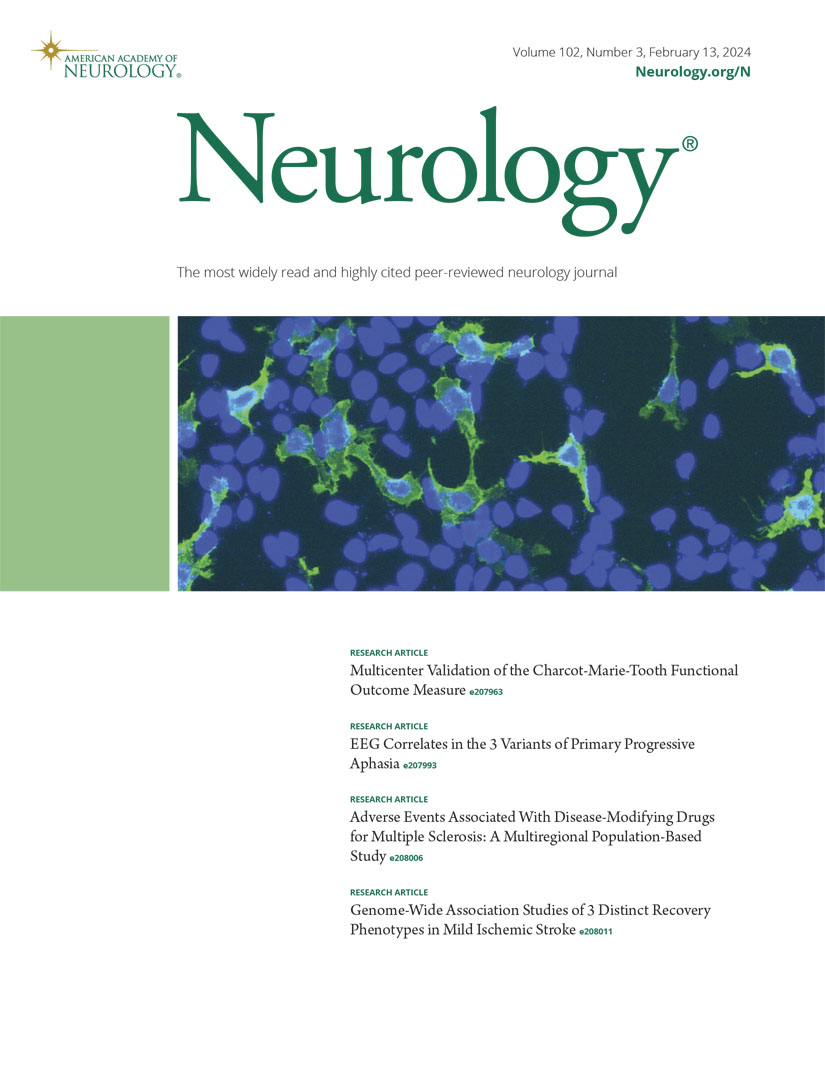与未感染艾滋病毒的人相比,在急性艾滋病毒诊断和治疗期间,脑白质高强度的积累更大。
IF 7.7
1区 医学
Q1 CLINICAL NEUROLOGY
引用次数: 0
摘要
背景与目的艾滋病毒感染者(PWH)即使在抗逆转录病毒治疗(ART)和病毒抑制后,缺血性卒中的发生率也有所增加。脑MRI上的脑白质高信号(WMHs)与中风和认知障碍的风险增加有关。本研究试图与未感染艾滋病毒的人相比,在急性艾滋病毒感染期间和早期开始抗逆转录病毒治疗后,对脑wmh进行表征和量化。方法从泰国RV254/SEARCH010队列中确定诊断为急性HIV感染(AHI)的参与者和人口统计学匹配的无HIV (PWoH)人群。纳入标准为18岁及以上;排除标准为精神障碍史、神经障碍史或妊娠史。在入组时和两年随访时完成配对3T MRI脑部扫描的参与者被纳入分析。从T2流体衰减反演恢复序列中提取WMH数据,并将其标准化为颅内总容积,生成WMH体积变化指标。采用重复测量方差分析(repeated-measures ANOVA)检验每组WMH随时间的变化,并使用参数和非参数检验将WMH变化与HIV疾病测量和血管合并症进行比较。结果RV254患者72例(PWH, 99%为男性),PWoH 37例(100%为男性),平均年龄31岁。PWH暴露于HIV的平均估计持续时间为21天(SD = 9)。两组患者的血管合并症发生率都很低。在基线时,各组间wmh的体积没有差异。然而,尽管无法检测到血浆病毒载量,但PWH组2年内WMH体积的增加(平均21.6%)比PWoH组(平均5.8%,p = 0.004,偏η2 = 0.075, Cohen d = 0.597)更大。在PWH组中,高血压和高BMI与wmh的增加相关(分别为p = 0.038和p = 0.016)。WMH积累越大,PWH患者CD4+ t细胞基线计数也越高(r = 0.272, p = 0.021)。尽管开始抗逆转录病毒治疗和病毒抑制,年轻的AHI泰国男性在2年内表现出比PWoH更大的WMH进展。这些数据表明,在早期感染期间,脑白质易受HIV感染,与血管合并症或生活方式因素无关。局限性包括性别和种族的同质性以及随访期限制为24个月。本文章由计算机程序翻译,如有差异,请以英文原文为准。
Greater Accumulation of Brain White Matter Hyperintensities in People Diagnosed and Treated During Acute HIV Compared With People Without HIV.
BACKGROUND AND OBJECTIVES
People living with HIV (PWH) have increased rates of ischemic stroke even after antiretroviral therapy (ART) and viral suppression. Cerebral white matter hyperintensities (WMHs) on brain MRI are associated with an increased risk of stroke and cognitive impairment. This study sought to characterize and quantify brain WMHs during acute HIV infection and after early ART initiation compared with people without HIV.
METHODS
Participants diagnosed with acute HIV infection (AHI) from the RV254/SEARCH010 cohort in Thailand and demographically matched people without HIV (PWoH) were identified. The inclusion criterion was age 18 years or older; exclusion criteria were history of psychiatric disorder, neurologic disorder, or pregnancy. Participants who had paired 3T MRI brain scans completed at enrollment and at two-year follow-up were included in the analysis. WMH data were extracted from T2 fluid-attenuated inversion recovery sequences and standardized to total intracranial volume to generate an index of WMH volume change. A repeated-measures ANOVA was used to test for WMH change over time per group, and WMH change was compared with HIV disease measures and vascular comorbidities using parametric and nonparametric testing.
RESULTS
Seventy-two RV254 participants (PWH, 99% male) and 37 PWoH (100% male), with a mean age of 31 years, were included. PWH had a mean estimated duration of exposure to HIV of 21 days (SD = 9). Both groups had very low rates of vascular comorbidities. At baseline, the volume of WMHs did not differ between groups. However, there was a greater increase in WMH volume over 2 years in PWH (mean 21.6%) compared with PWoH (mean 5.8%, p = 0.004, partial η2 = 0.075, Cohen d = 0.597) despite undetectable plasma viral load. Within PWH, hypertension and higher BMI were associated with a greater increase in WMHs (p = 0.038 and p = 0.016, respectively). Greater WMH accumulation also correlated with higher baseline CD4+ T-cell count in PWH (r = 0.272, p = 0.021).
DISCUSSION
Young Thai men with AHI demonstrated greater WMH progression than PWoH over 2 years despite ART initiation and viral suppression. These data suggest that brain white matter is vulnerable to HIV during early infection, independent from vascular comorbidities or lifestyle factors. Limitations include homogeneity in sex and ethnicity and follow-up period limited to 24 months.
求助全文
通过发布文献求助,成功后即可免费获取论文全文。
去求助
来源期刊

Neurology
医学-临床神经学
CiteScore
12.20
自引率
4.00%
发文量
1973
审稿时长
2-3 weeks
期刊介绍:
Neurology, the official journal of the American Academy of Neurology, aspires to be the premier peer-reviewed journal for clinical neurology research. Its mission is to publish exceptional peer-reviewed original research articles, editorials, and reviews to improve patient care, education, clinical research, and professionalism in neurology.
As the leading clinical neurology journal worldwide, Neurology targets physicians specializing in nervous system diseases and conditions. It aims to advance the field by presenting new basic and clinical research that influences neurological practice. The journal is a leading source of cutting-edge, peer-reviewed information for the neurology community worldwide. Editorial content includes Research, Clinical/Scientific Notes, Views, Historical Neurology, NeuroImages, Humanities, Letters, and position papers from the American Academy of Neurology. The online version is considered the definitive version, encompassing all available content.
Neurology is indexed in prestigious databases such as MEDLINE/PubMed, Embase, Scopus, Biological Abstracts®, PsycINFO®, Current Contents®, Web of Science®, CrossRef, and Google Scholar.
 求助内容:
求助内容: 应助结果提醒方式:
应助结果提醒方式:


